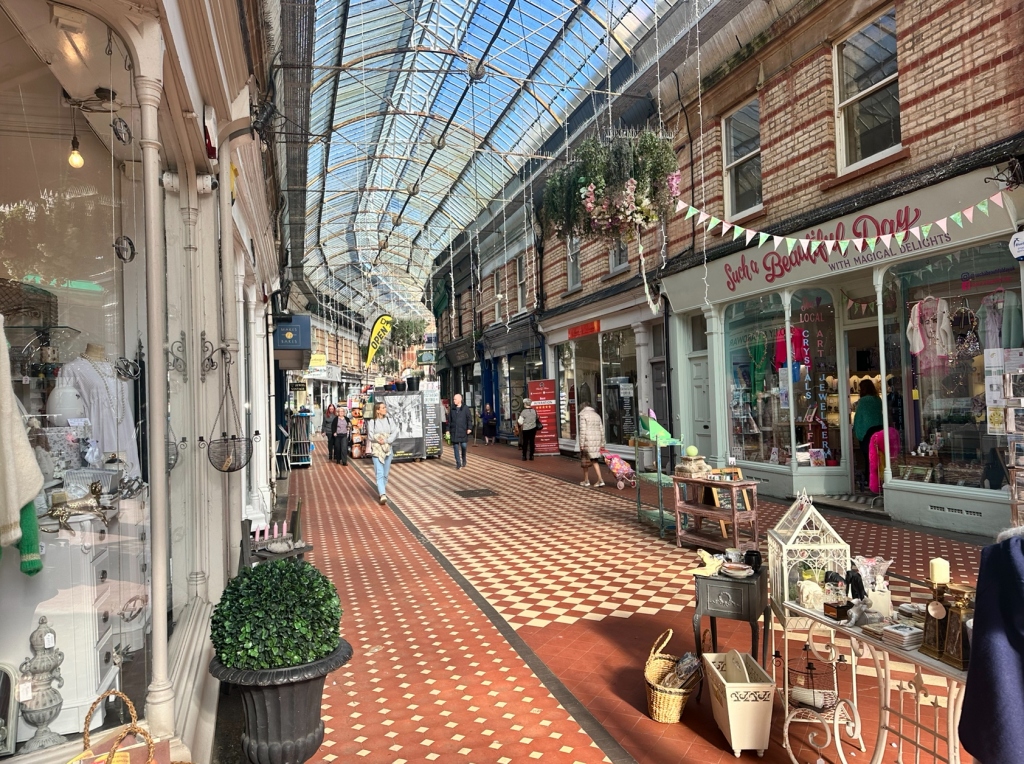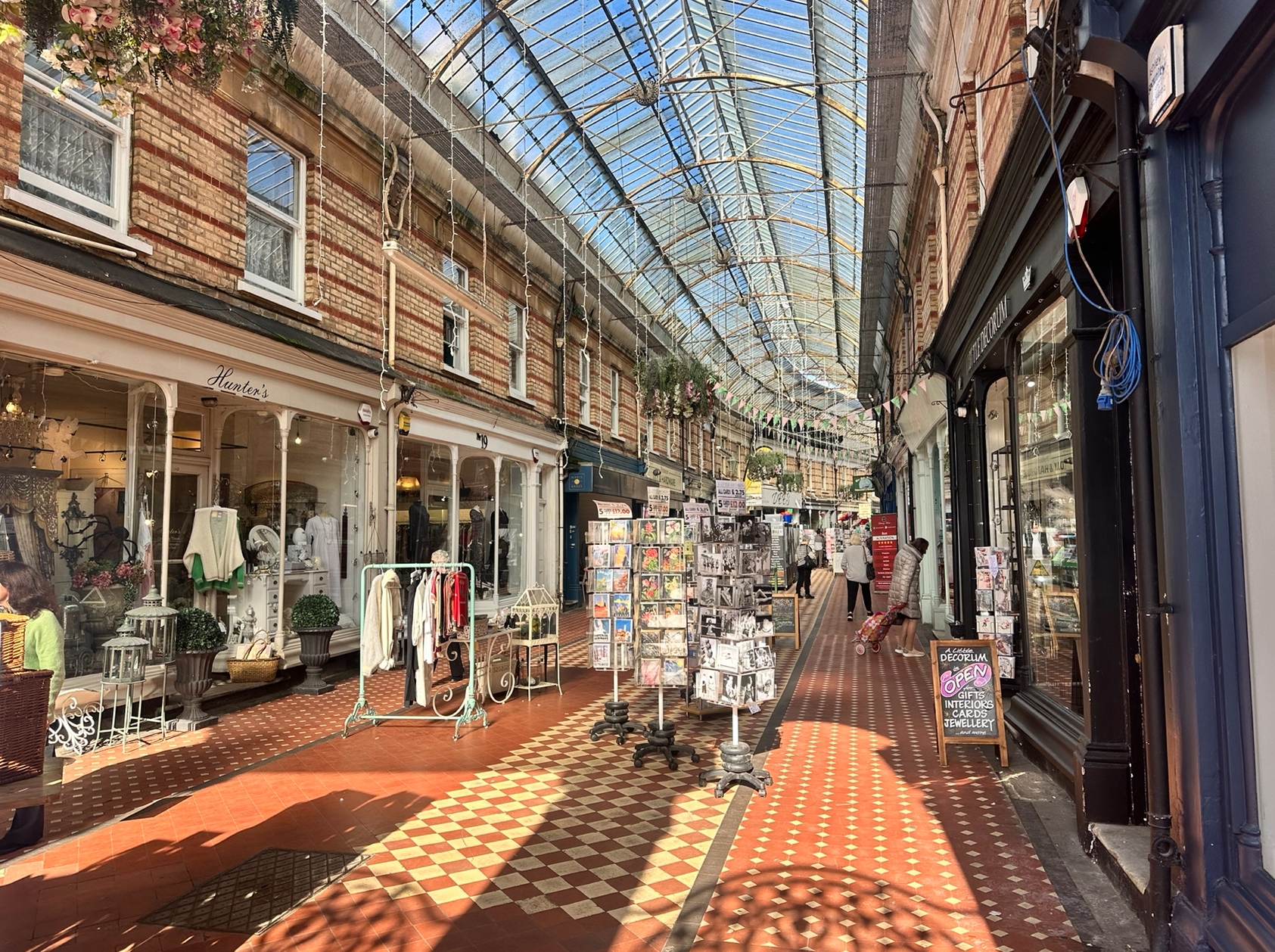Bournemouth boasts a rich cultural heritage reflected in its landmarks, which blend historical significance, architectural beauty, and artistic vibrancy.
Bournemouth’s cultural landmarks offer a compelling mix of heritage, art, and community spirit, making the town a dynamic destination for cultural exploration. Each site, from the intimate Westbourne Arcade to the grand Russell-Cotes Museum, contributes to a rich tapestry that celebrates both past and present.
Below is an overview of key cultural landmarks in Bournemouth, highlighting their significance and appeal for visitors.
1. Westbourne Arcade
- Location: Westbourne, BH4 9AY (between Poole Road and Seamoor Road).
- Description: A Grade II Listed Victorian shopping arcade, built in 1884-5 by Henry Joy, known for its red brick façades, Gothic-style windows, and glazed roof. It houses independent shops, cafés, and the UK’s smallest cinema, Bournemouth Colosseum (19-20 seats), offering arthouse films.
- Cultural Significance: A hub for local commerce and culture, its fully tenanted status and eclectic businesses (e.g., Don Strike Music Shop, Renoufs Pantry) reflect Bournemouth’s support for independent enterprises. The arcade’s preserved Victorian architecture and community ambiance make it a cultural gem.
- Visitor Experience: Ideal for shopping, dining, or a unique cinema visit. Open daily, with most shops operating 9:00 AM–5:30 PM (check individual hours).
2. Bournemouth Pier
- Location: Pier Approach, BH2 5AA.
- Description: A historic pier, originally built in 1856 and rebuilt in 1880, extending 1,000 feet into the sea. It features the Pier Theatre, amusement arcades, a zip-line, and panoramic views of Bournemouth’s coastline.
- Cultural Significance: A symbol of Bournemouth’s seaside heritage, the pier hosts cultural events like live music, comedy shows, and seasonal festivals. The Key West Restaurant at the pier’s end offers dining with stunning views.
- Visitor Experience: Open year-round (weather-dependent for some activities), with entry free but attractions ticketed. Perfect for families, couples, or photography enthusiasts.
3. Russell-Cotes Art Gallery & Museum
- Location: East Cliff Promenade, BH1 3AA.
- Description: A late-Victorian mansion turned museum, donated to Bournemouth in 1922 by Sir Merton and Lady Russell-Cotes. It houses an extensive collection of 19th-century art, Asian artifacts, and theatrical memorabilia, set within opulent interiors.
- Cultural Significance: One of the UK’s finest house-museums, it showcases Bournemouth’s historical affluence and cosmopolitan tastes. Temporary exhibitions and events, such as art talks and workshops, keep it dynamic.
- Visitor Experience: Open Tuesday–Sunday, 10:00 AM–5:00 PM (check for seasonal variations). Entry fees apply, with concessions available. Guided tours and a café enhance the visit.
4. Bournemouth Lower, Central, and Upper Gardens
- Location: Central Bournemouth, stretching from the Pier to Branksome.
- Description: A series of Grade II Listed Victorian gardens, established in the 1870s, spanning 3 kilometers. Features include floral displays, the Pine Walk open-air art gallery, a miniature railway, and the Bournemouth Balloon (tethered helium balloon offering aerial views).
- Cultural Significance: A green heart of Bournemouth, the gardens host cultural events like the Bournemouth Arts by the Sea Festival, outdoor concerts, and community markets. They reflect the town’s commitment to public spaces and horticultural heritage.
- Visitor Experience: Free to enter, open daily. Ideal for leisurely walks, picnics, or seasonal events. The Balloon operates weather-permitting (ticketed).
5. St. Peter’s Church
- Location: Hinton Road, BH1 2EE.
- Description: A Grade I Listed Gothic Revival church, completed in 1879, designed by G.E. Street. Known for its ornate architecture, stained-glass windows, and the tomb of Mary Shelley, author of Frankenstein.
- Cultural Significance: A spiritual and literary landmark, it connects Bournemouth to global literary history. Regular choral services and concerts highlight its acoustic and cultural role.
- Visitor Experience: Open daily for visitors (check service times). Free entry, with guided tours available. A peaceful spot for reflection or architectural appreciation.
6. Bournemouth Pavilion Theatre
- Location: Westover Road, BH1 2BU.
- Description: A Grade II Listed Art Deco theatre, opened in 1929, hosting a diverse program of plays, musicals, comedy, and dance. Its adjacent Ballroom is used for events and exhibitions.
- Cultural Significance: A cornerstone of Bournemouth’s performing arts scene, it supports both local and touring productions, fostering cultural engagement. Its architecture reflects the town’s interwar glamour.
- Visitor Experience: Open for performances and events (check schedules online). Tickets vary by show. The Pavilion’s café and bar are popular pre-show spots.
7. Boscombe Pier and Arts Quarter
- Location: Boscombe Seafront, BH5 1BN.
- Description: A restored Edwardian pier (reopened 2010) with musical heritage (home to the world’s first “musical decking”) and nearby Boscombe’s arts quarter, featuring street art, galleries, and the O2 Academy music venue.
- Cultural Significance: Boscombe’s regeneration has made it a hub for contemporary arts and music, with murals and independent galleries showcasing local talent. The pier hosts community events and art installations.
- Visitor Experience: Pier entry is free, open daily (weather-dependent). The arts quarter is best explored on foot, with cafés and shops nearby. Check for live music or festival dates.

